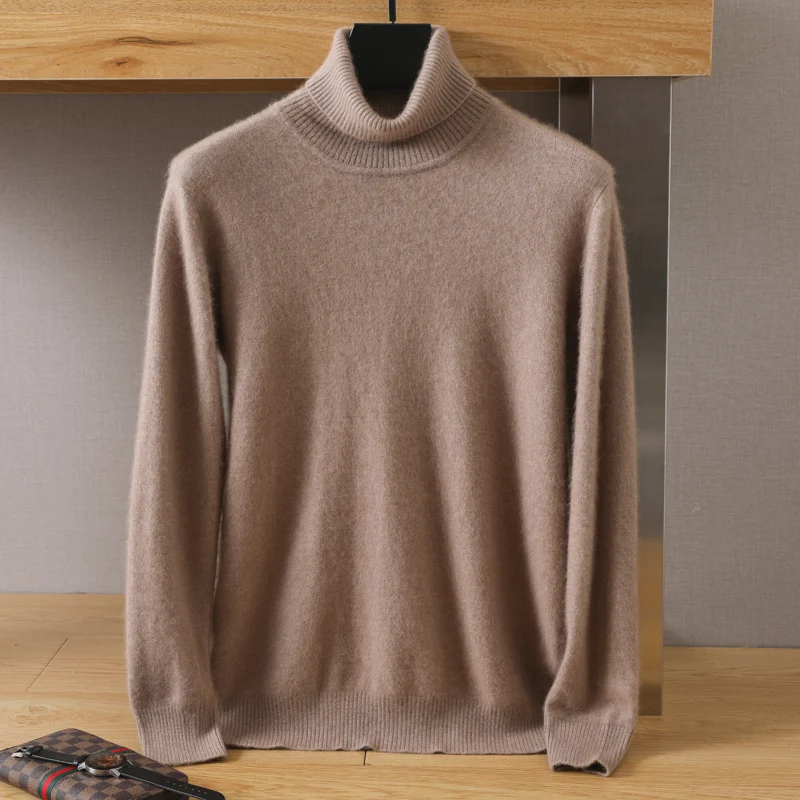The Foundation of Premium Cashmere: What Are Knit Density and Ply?
When shopping for premium cashmere, you’ll often hear terms like “gauge” and “ply” tossed around. These aren’t just fancy industry jargon—they’re fundamental characteristics that determine how your cashmere will look, feel, and perform over time.
Knit density, commonly referred to as gauge, measures how tightly or loosely a cashmere fabric is knitted. Technically speaking, it’s the number of stitches per inch or centimeter in the finished fabric. In the industry, gauge is often labeled with “GG” (gauge guide) followed by a number. The higher the number, the finer and denser the knit. For instance, a 7GG cashmere piece has fewer, larger stitches per inch than a 12GG piece, which creates a more compact fabric with smaller stitches.
Ply, on the other hand, refers to the number of yarn strands twisted together to create a single thread used in knitting. Contrary to popular belief, higher ply count doesn’t automatically mean better quality—it simply indicates a different type of yarn construction that serves specific purposes.
These two elements work in tandem to create the distinct characteristics that make each cashmere piece unique. Understanding them helps you make informed decisions about which cashmere items best suit your needs.
| Term | Definition | Measurement | Impact on Fabric |
|---|---|---|---|
| Gauge/Knit Density | Number of stitches per unit of measurement | 3GG to 18GG (industry standard) | Determines fabric thickness, weight, drape, and appearance |
| Ply | Number of yarn strands twisted together | Usually 1-ply to 4-ply | Affects warmth, durability, and thickness of yarn |
The relationship between these factors forms the foundation for understanding cashmere quality. Proper styling tips for cashmere cardigans often take into account these fundamental properties to ensure your garments maintain their luxurious feel and appearance over time.
How Knit Density Affects Cashmere’s Most Valued Properties
Knit density is much more than a technical specification—it directly influences virtually every quality aspect of your cashmere garment.
Softness and tactile experience: The density of knitting affects how cashmere feels against your skin. While cashmere is inherently soft, knit density can either enhance or diminish this natural quality. Higher gauge fabrics (12GG and above) often feel smoother and more refined, while lower gauge fabrics (7GG and below) can emphasize the plush, cozy aspects of cashmere.
Durability and resistance to wear: Perhaps surprisingly, denser knits typically demonstrate better durability over time. The tighter construction means:
– Less friction between individual fibers
– Reduced likelihood of pilling
– Better resilience against stretching
– Improved shape retention after washing
Warmth-to-weight ratio: Cashmere’s renowned insulating properties vary significantly with knit density. Medium gauge fabrics (8-12GG) typically provide the optimal balance between warmth and weight. The science behind this involves air pockets—knit density determines how many tiny air pockets exist within the fabric structure to trap body heat while still allowing breathability.
Visual appearance and drape: The way a cashmere piece hangs on the body is largely determined by its knit density. Higher gauges create fabrics that flow more elegantly and show more detailed stitching patterns, while lower gauges produce more substantial, structured pieces.
Weight and thickness: Naturally, looser knits (lower gauge numbers) yield thicker, heavier garments, while tighter knits (higher gauge numbers) produce lighter, more refined pieces.
These properties don’t exist in isolation—they work together to define the overall quality experience. Understanding these relationships helps you recognize why certain cashmere sweaters perform differently despite using the same quality of raw cashmere fiber.
The Misunderstood Influence of Ply on Cashmere Performance
When it comes to cashmere quality, ply count is perhaps the most misunderstood characteristic. Let’s separate myth from reality.
Myth: Higher ply always means better quality cashmere
Reality: Ply count should match the intended use of the garment. A 1-ply garment made from exceptional cashmere fibers can outperform a 4-ply item made from inferior materials.
The true relationship between ply and performance is nuanced:
Durability and strength: Multiple plies can provide additional structural integrity, but only if the base fibers are high quality. Two-ply yarns often represent the sweet spot for everyday cashmere items, offering reinforced strength without excessive weight.
Warmth and insulation: While adding plies typically increases warmth, it’s not a linear relationship. The quality of the air trapped between fibers matters more than simply adding more yarn. A well-constructed 2-ply sweater can provide similar warmth to a bulkier 4-ply version while maintaining better drape.
Softness perception: Interestingly, single-ply ultra-fine cashmere can feel remarkably soft because it allows the natural properties of the fiber to shine. Additional plies may add bulk but don’t necessarily enhance the luxurious hand-feel that cashmere is prized for.
Weight and drape: Each additional ply adds weight and structure to the finished garment. For lightweight summer scarves, a single-ply construction is ideal, while winter sweaters may benefit from 2-ply or higher to provide substance and lasting warmth.

The twisted structure of multi-ply yarns creates additional resilience and can improve a garment’s ability to maintain its shape over time. However, for certain applications like ultra-fine knits, single-ply yarns allow for the creation of exceptionally light, delicate fabrics that would be impossible with multiple plies.
Understanding cashmere yarn weight considerations helps you make more informed decisions about which type of construction will best suit your specific needs and preferences.
The Perfect Balance: How Gauge and Ply Work Together
The magic of truly exceptional cashmere happens when gauge and ply work in perfect harmony. Like partners in a dance, these elements must be properly balanced to achieve the desired result.
Most premium cashmere manufacturers carefully select specific gauge and ply combinations based on the intended purpose of each garment. This concept of “appropriate density” means finding the right combination for specific applications rather than simply maximizing either characteristic.
The interplay between these elements is fascinating:
– A high-gauge fabric with single-ply yarn creates lightweight, refined pieces perfect for layering
– Medium-gauge fabrics with two-ply construction offer versatile, everyday luxury with excellent durability
– Low-gauge fabrics with multi-ply yarn produce substantial winter pieces with maximum warmth
The table below illustrates common combinations and their typical applications:
| Gauge | Ply | Typical Use | Key Properties |
|---|---|---|---|
| 3-7GG | 2-4 ply | Heavy sweaters, winter cardigans | Maximum warmth, substantial feel, pronounced texture |
| 8-12GG | 2-ply | Standard sweaters, versatile pullovers | Balanced warmth, good durability, classic appearance |
| 12-16GG | 1-2 ply | Fine knits, lightweight layers | Refined drape, elegant appearance, moderate warmth |
| 16+GG | 1-ply | Ultralight layers, summer cashmere | Exceptional lightness, silky feel, cooling properties |
The right combination maximizes cashmere’s natural properties—its remarkable softness, insulating capabilities, and luxurious appearance. By understanding this relationship, you can better appreciate the craftsmanship behind well-designed men’s cashmere pullovers and other premium cashmere items.
The Density Spectrum: Common Cashmere Gauges and Their Ideal Uses
Different gauge ranges serve distinct purposes in the cashmere world. Understanding where your garment falls on this spectrum helps you select the right piece for your needs and care for it appropriately.
Low gauge (3-7GG): Chunky comfort
– Optimal uses: Heavy winter sweaters, substantial outerwear pieces
– Care considerations: May be prone to snagging on rough surfaces
– Performance characteristics: Maximum warmth, pronounced texture, substantial feel
– Seasonal appropriateness: Ideal for cold weather, too warm for transitional seasons
Medium gauge (8-12GG): Versatile classics
– Optimal uses: Everyday sweaters, versatile cardigans, business casual pieces
– Care considerations: Good balance of durability and softness
– Performance characteristics: Balanced warmth-to-weight ratio, traditional cashmere appearance
– Seasonal appropriateness: Three-season wear (fall, winter, spring)
High gauge (12-16GG): Refined elegance
– Optimal uses: Fine knits, lightweight layering pieces, dressy options
– Care considerations: Handle with care to preserve delicate construction
– Performance characteristics: Exceptional drape, smooth appearance, moderate insulation
– Seasonal appropriateness: Extended seasonal versatility, works well in temperature-controlled environments
Ultra-high gauge (16+GG): Ultimate luxury
– Optimal uses: Premium lightweight layers, summer cashmere, luxury accessories
– Care considerations: Requires gentle handling and specialized care
– Performance characteristics: Silky feel, incredible lightness, cooling properties
– Seasonal appropriateness: Works year-round including moderate summer weather
The gauge range you choose should reflect both your practical needs and aesthetic preferences. For instance, a banker might prefer high-gauge cashmere for its refined appearance under a suit, while someone in a colder climate might prioritize the substantial warmth of low-gauge pieces.
Understanding these differences helps you build a cashmere collection that serves your lifestyle needs. The authentic cashmere tactile guide provides additional insights into recognizing quality through touch and feel across different gauge ranges.
How to Identify Quality Through Knit Density: Expert Assessment Techniques
Developing the ability to assess knit density helps you make more informed cashmere purchases. Here are practical techniques used by industry experts:

Visual inspection techniques:
– Look for even, consistent stitching throughout the garment
– Check that rows align properly with no irregular gaps or bunching
– Examine seams for clean finishes appropriate to the gauge
– Assess overall evenness of the fabric surface
Tactile assessment methods:
1. Gently stretch the fabric between your fingers (about 1-2 inches)
2. Release and observe how quickly it returns to shape
3. High-quality dense knits should recover immediately
4. Rub the fabric between your fingers to check for fiber shedding
Label information:
While not all brands disclose technical specifications, quality cashmere often includes:
– Gauge number (e.g., “12GG”)
– Ply information (e.g., “2-ply cashmere”)
– Fiber grade or quality designation
Warning signs regardless of specifications:
– Uneven stitches or visible holes at stress points
– Excessive shedding when gently rubbed
– Fabric that feels limp or lacks resilience when handled
When assessing knit density, remember to consider it alongside other quality factors like fiber fineness and length. The best cashmere combines excellent raw materials with appropriate construction techniques for the intended use.
For a deeper understanding of all quality factors, the definitive guide to classic cashmere fabric provides comprehensive information on evaluating overall cashmere quality beyond just knit density.
The Value Equation: Why Knit Density Affects Cashmere Pricing
Understanding why denser knits often command higher prices helps you make informed purchasing decisions and recognize genuine value.
Higher gauge, denser knits typically cost more to produce for several important reasons:
- Material requirements: Denser knits require more yarn per square inch, increasing raw material costs
- Production time: Fine-gauge machines operate more slowly than those producing chunky knits
- Technical expertise: Creating consistent, high-quality dense knits requires more skilled craftspeople
- Quality control: Finer knits demand more rigorous inspection processes to ensure perfection
From a consumer perspective, this price difference represents a value proposition rather than just an expense. Dense, high-gauge cashmere typically offers:
- Extended garment lifespan due to improved durability
- Better resistance to pilling and shape distortion
- More versatile styling options due to refined appearance
- Enhanced drape and comfort
When viewed through the lens of cost-per-wear (total cost divided by number of wears over lifetime), higher-quality dense knits often represent a better long-term value despite the initial investment. A well-constructed 12GG cashmere sweater might last for 10+ years with proper care, while a lower-quality alternative might need replacement after just a couple of seasons.
This value proposition is particularly evident in timeless styles like cashmere turtlenecks where the refined knit structure enhances both the appearance and performance of these versatile pieces.
Finding Your Perfect Density: Matching Cashmere Characteristics to Your Needs
Selecting the ideal knit density for your lifestyle ensures you’ll get the most enjoyment and value from your cashmere investment. Here’s how to match characteristics to your specific needs:
For cold climate daily wear:
Dense, medium-gauge (10-12GG) with 2-ply construction offers the ideal balance of warmth and durability for everyday use in colder regions. The tighter knit structure helps retain body heat while resisting wear from regular use.
For office environments:
High-gauge (12-16GG) options provide a refined appearance suitable for professional settings. These pieces layer beautifully under blazers or jackets without adding bulk, while still providing comfortable warmth in air-conditioned spaces.
For casual weekend luxury:
Medium to low gauge (7-10GG) with 2-ply construction creates comfortable, relaxed pieces that offer exceptional softness and substantial feel for weekend wear. These pieces excel at casual elegance while providing cozy comfort.
For travel and versatility:
Medium-gauge (10-12GG) single or 2-ply options offer the best packability and wrinkle resistance. Look for pieces that can be dressed up or down to maximize versatility in your travel wardrobe.

When balancing budget considerations against density preferences, remember that a well-chosen piece in a slightly lower gauge may provide better overall satisfaction than stretching for a higher-gauge option that doesn’t align with your lifestyle needs.
For styling inspiration that makes the most of different cashmere densities, explore creative styling options for cashmere cardigans that showcase the versatility of these timeless pieces.
Cashmere Wrap Sweaters, Women's Cashmere Pullovers
$75.89 Select options This product has multiple variants. The options may be chosen on the product pageCashmere Cable Knit Sweaters, Women's Cashmere Pullovers
Price range: $111.82 through $112.93 Select options This product has multiple variants. The options may be chosen on the product pageCropped Cashmere Sweaters, Women's Cashmere Pullovers
$155.77 Select options This product has multiple variants. The options may be chosen on the product pageOversized Cashmere Sweaters, Plus Size Cashmere Sweaters, Women's V-Neck Cashmere Sweaters
$136.87 Select options This product has multiple variants. The options may be chosen on the product page- Price range: $108.11 through $130.03 Select options This product has multiple variants. The options may be chosen on the product page
Striped Cashmere Sweaters, Women's Cashmere Pullovers
$139.68 Select options This product has multiple variants. The options may be chosen on the product page
Beyond Basics: How Processing and Treatment Affect Knit Density Performance
The performance of cashmere knits isn’t determined by density and ply alone—manufacturing processes significantly influence how these characteristics manifest in the final garment.
Finishing treatments play a crucial role in how cashmere feels against the skin. Some manufacturers use softening agents that temporarily enhance the initial hand-feel but may actually compromise the fabric’s long-term performance. Quality cashmere relies on the natural properties of the fiber enhanced through proper construction rather than artificial treatments.
Washing and blocking during production are critical steps that set the foundation for how the garment will perform. These processes stabilize the knit structure, ensuring that the chosen density performs as intended. Proper blocking allows the garment to achieve its designed dimensions and drape, particularly important for finer gauge pieces.
Some specialty treatments like brushing create a distinctive surface texture that modifies how the knit density is perceived. The gentle raising of fibers in brushed cashmere sweaters creates an ultra-soft surface while maintaining the structural benefits of the underlying knit density—offering the best of both worlds for those seeking maximum softness without sacrificing performance.
Sustainability Considerations: Balancing Density, Durability, and Environmental Impact
The relationship between knit density and sustainability deserves special attention in today’s environmentally conscious world.
Higher-quality, denser knit cashmere creates garments with substantially longer lifespans. A well-constructed cashmere piece can last decades rather than seasons, significantly reducing the environmental impact per wear. When you choose appropriate density for your specific needs, you’re making a choice that benefits both your wardrobe and the planet.
The environmental calculus of cashmere production means that investing in better-quality pieces actually reduces your fashion footprint over time. Consider these sustainability advantages of quality-focused purchasing:
- Reduced frequency of replacement means fewer resources used over time
- Higher-quality cashmere requires fewer chemical treatments to maintain appearance
- Durable pieces eliminate waste associated with fast fashion cycles
- Timeless construction encourages longer wearing periods before recycling
Finding stylish ways to wear cashmere cardigans throughout changing fashion cycles helps maximize the sustainability benefits of your quality cashmere investments, ensuring these pieces remain in active rotation in your wardrobe for years to come.
By understanding how knit density and ply contribute to both quality and longevity, you’re empowered to make choices that align with both your aesthetic preferences and values around responsible consumption.







